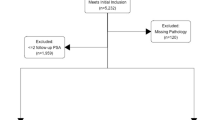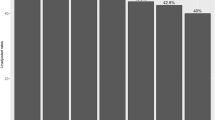Abstract
Background
Certain widely used pathological outcome prediction models that were developed in tertiary centers tend to overpredict outcomes in the community setting; thus, the Michigan Urological-Surgery Improvement Collaborative (MUSIC) model was developed in general urology practice to address this issue. Additionally, the development of these models involved a relatively small proportion of Black men, potentially compromising the accuracy of predictions in this patient group. We tested the validity of the MUSIC and three widely used nomograms to compare their overall and race-stratified predictive performance.
Methods
We extracted data from 4139 (1138 Black) men from the Shared Equal Access Regional Cancer Hospital (SEARCH) database of the Veterans Affairs health system. The predictive performance of the MUSIC model was compared to the Memorial-Sloan Kettering (MSK), Briganti-2012, and Partin-2017 models for predicting lymph-node invasion (LNI), extra-prostatic extension (EPE), and seminal vesicle invasion (SVI).
Results
The median PSA of Black men was higher than White men (7.8 vs. 6.8 ng/ml), although they were younger by a median of three years and presented at a lower-stage disease. MUSIC model showed comparable discriminatory capacity (AUC:77.0%) compared to MSK (79.2%), Partin-2017 (74.6%), and Briganti-2012 (76.3%), with better calibration for LNI. AUCs for EPE and SVI were 72.7% and 76.9%, respectively, all comparable to the MSK and Partin models. LNI AUCs for Black and White men were 69.6% and 79.6%, respectively, while EPE and SVI AUCs were comparable between races. EPE and LNI had worse calibration in Black men. Decision curve analysis showed MUSIC superiority over the MSK model in predicting LNI, especially among Black men.
Conclusion
Although the discriminatory performance of all models was comparable for each outcome, the MUSIC model exhibited superior net benefit to the MSK model in predicting LNI outcomes among Black men in the SEARCH population.
This is a preview of subscription content, access via your institution
Access options
Subscribe to this journal
Receive 4 print issues and online access
$259.00 per year
only $64.75 per issue
Buy this article
- Purchase on Springer Link
- Instant access to full article PDF
Prices may be subject to local taxes which are calculated during checkout



Similar content being viewed by others
Data availability
The datasets generated during and/or analyzed during the current study are available from the corresponding author upon reasonable request.
References
Schaeffer EM, Srinivas S, Adra N, An Y, Barocas D, Bitting R, et al. Prostate Cancer, Version 4.2023, NCCN Clinical Practice Guidelines in Oncology. J Natl Compr Canc Netw. 2023;21:1067–96.
Ötleş E, Denton BT, Qu B, Murali A, Merdan S, Auffenberg GB, et al. Development and validation of models to predict pathological outcomes of radical prostatectomy in regional and national cohorts. J Urol. 2022;207:358–66.
Brady Urological Institute. Partin Tables Prostate Cancer Risk Assessment Tool. 2021. Available from: https://www.hopkinsmedicine.org/brady-urology-institute/conditions_and_treatments/prostate_cancer/risk_assessment_tools/partin-tables.html.
Briganti A, Larcher A, Abdollah F, Capitanio U, Gallina A, Suardi N, et al. Updated nomogram predicting lymph node invasion in patients with prostate cancer undergoing extended pelvic lymph node dissection: the essential importance of percentage of positive cores. Eur Urol. 2012;61:480–7.
Cagiannos I, Karakiewicz P, Eastham JA, Ohori M, Rabbani F, Gerigk C, et al. A preoperative nomogram identifying decreased risk of positive pelvic lymph nodes in patients with prostate cancer. J Urol. 2003;170:1798–803.
Memorial Sloan Kettering Cancer Center. Dynamic Prostate Cancer Nomogram: Coefficients. 2022. Available from: https://www.mskcc.org/nomograms/prostate/pre_op/coefficients.
Bandini M, Marchioni M, Preisser F, Nazzani S, Tian Z, Fossati N, et al. A head-to-head comparison of four prognostic models for prediction of lymph node invasion in African American and Caucasian individuals. Eur Urol Focus. 2019;5:449–56.
Preisser F, van den Bergh RCN, Gandaglia G, Ost P, Surcel CI, Sooriakumaran P, et al. Effect of Extended Pelvic Lymph Node Dissection on Oncologic Outcomes in Patients with D’Amico Intermediate and High Risk Prostate Cancer Treated with Radical Prostatectomy: A Multi-Institutional Study. J Urol. 2020;203:338–43.
Cimino S, Reale G, Castelli T, Favilla V, Giardina R, Russo GI, et al. Comparison between Briganti, Partin and MSKCC tools in predicting positive lymph nodes in prostate cancer: a systematic review and meta-analysis. Scand J Urol. 2017;51:345–50.
Milonas D, Venclovas Z, Muilwijk T, Jievaltas M, Joniau S. External validation of Memorial Sloan Kettering Cancer Center nomogram and prediction of optimal candidate for lymph node dissection in clinically localized prostate cancer. Cent Eur J Urol. 2020;73:19–25.
Hueting TA, Cornel EB, Somford DM, Jansen H, van Basten JA, Pleijhuis RG, et al. External Validation of Models Predicting the Probability of Lymph Node Involvement in Prostate Cancer Patients. Eur Urol Oncol. 2018;1:411–7.
Bandini M, Marchioni M, Pompe RS, Tian Z, Gandaglia G, Fossati N, et al. First North American validation and head-to-head comparison of four preoperative nomograms for prediction of lymph node invasion before radical prostatectomy. BJU Int. 2018;121:592–9.
Diamand R, Ploussard G, Roumiguié M, Oderda M, Benamran D, Fiard G, et al. External Validation of a Multiparametric Magnetic Resonance Imaging-based Nomogram for the Prediction of Extracapsular Extension and Seminal Vesicle Invasion in Prostate Cancer Patients Undergoing Radical Prostatectomy. Eur Urol. 2021;79:180–5.
Hall WA, Fishbane N, Liu Y, Xu MJ, Davicioni E, Mahal BA, et al. Development and Validation of a Genomic Tool to Predict Seminal Vesicle Invasion in Adenocarcinoma of the Prostate. JCO Precis Oncol. 2020;4:1228–38.
Eissa A, Elsherbiny A, Zoeir A, Sandri M, Pirola G, Puliatti S, et al. Reliability of the different versions of Partin tables in predicting extraprostatic extension of prostate cancer: a systematic review and meta-analysis. Minerva Urol Nefrol. 2019;71:457–78.
Blas L, Shiota M, Nagakawa S, Tsukahara S, Matsumoto T, Lee K, et al. Validation of user-friendly models predicting extracapsular extension in prostate cancer patients. Asian J Urol. 2023;10:81–8.
de Rooij M, Hamoen EH, Witjes JA, Barentsz JO, Rovers MM. Accuracy of Magnetic Resonance Imaging for Local Staging of Prostate Cancer: A Diagnostic Meta-analysis. Eur Urol. 2016;70:233–45.
Zhu M, Gao J, Han F, Yin L, Zhang L, Yang Y, et al. Diagnostic performance of prediction models for extraprostatic extension in prostate cancer: a systematic review and meta-analysis. Insights Imaging. 2023;14:140.
Mehralivand S, Shih JH, Harmon S, Smith C, Bloom J, Czarniecki M, et al. A Grading System for the Assessment of Risk of Extraprostatic Extension of Prostate Cancer at Multiparametric MRI. Radiology. 2019;290:709–19.
Nyarangi-Dix J, Wiesenfarth M, Bonekamp D, Hitthaler B, Schütz V, Dieffenbacher S, et al. Combined Clinical Parameters and Multiparametric Magnetic Resonance Imaging for the Prediction of Extraprostatic Disease-A Risk Model for Patient-tailored Risk Stratification When Planning Radical Prostatectomy. Eur Urol Focus. 2020;6:1205–12.
Lillard JW Jr., Moses KA, Mahal BA, George DJ. Racial disparities in Black men with prostate cancer: A literature review. Cancer. 2022;128:3787–95.
Acknowledgements
This material is the result of work supported with resources and the use of facilities at the VA Caribbean Healthcare System. The contents of this publication do not represent the views of the VA Caribbean Healthcare System, the Department of Veterans Affairs, or the United States Government.
Author information
Authors and Affiliations
Contributions
Study concept and design: ESA; MM, Acquisition of data: Institute for Medical Research Team, Drafting of the manuscript: MM; SD, Critical revision of the manuscript: TJP; SJF; ESA; SD; MM; LG; CLA; WJA; CJK; MKT; LGR; MRC; ZK, Statistical analysis: LG, Supervision: TJP; SJF.
Corresponding author
Ethics declarations
Competing interests
The authors declare no competing interests.
Additional information
Publisher’s note Springer Nature remains neutral with regard to jurisdictional claims in published maps and institutional affiliations.
Supplementary information
Rights and permissions
About this article
Cite this article
Mottaghi, M., Gu, L., Deivasigamani, S. et al. Addressing racial disparities in prostate cancer pathology prediction models: external validation and comparison of four models of pathological outcome prediction before radical prostatectomy in the multiethnic SEARCH cohort. Prostate Cancer Prostatic Dis (2024). https://doi.org/10.1038/s41391-024-00830-2
Received:
Revised:
Accepted:
Published:
DOI: https://doi.org/10.1038/s41391-024-00830-2



